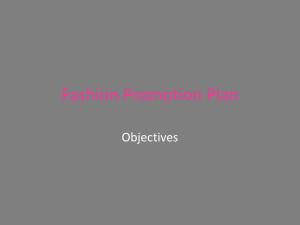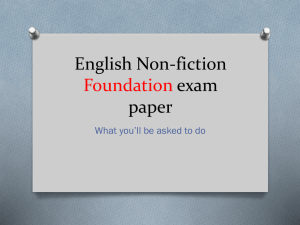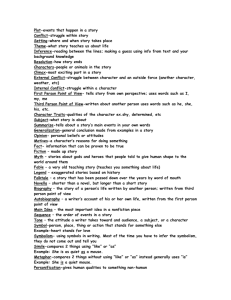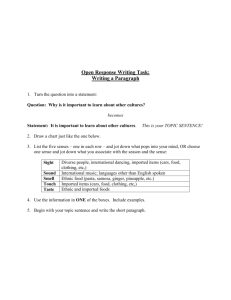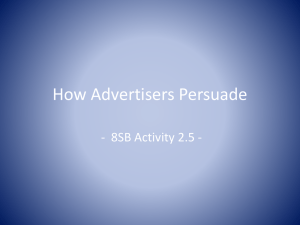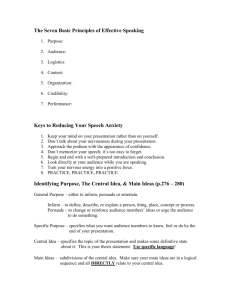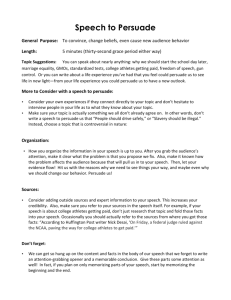Intensifying/Downplaying Model of Persuasion
advertisement
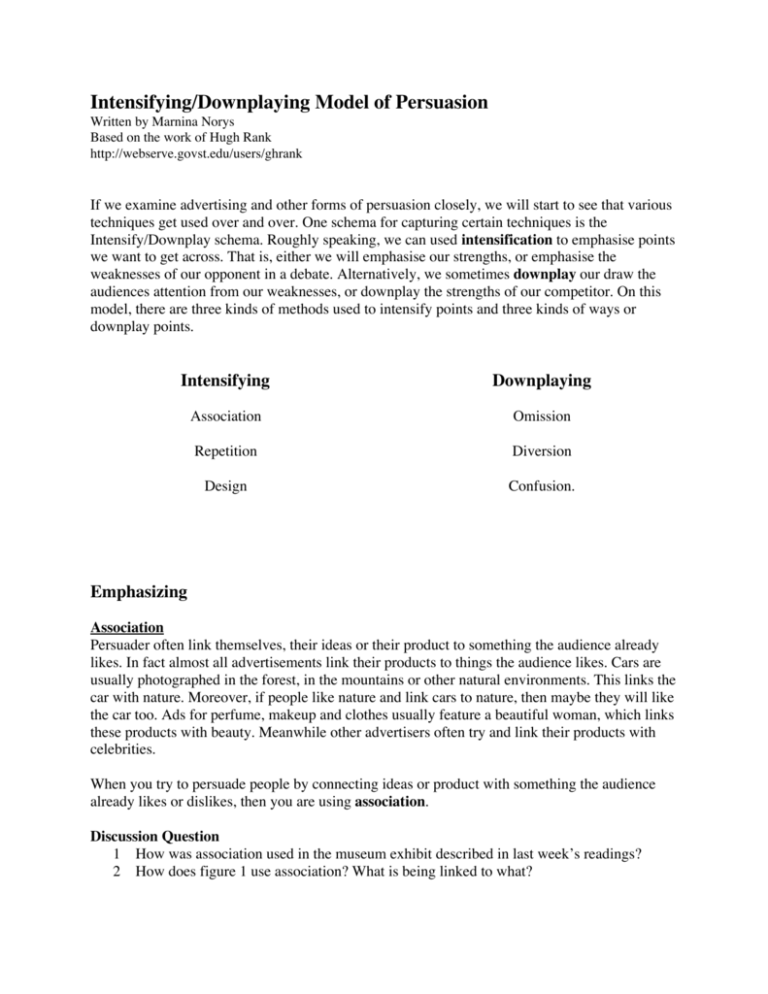
Intensifying/Downplaying Model of Persuasion Written by Marnina Norys Based on the work of Hugh Rank http://webserve.govst.edu/users/ghrank If we examine advertising and other forms of persuasion closely, we will start to see that various techniques get used over and over. One schema for capturing certain techniques is the Intensify/Downplay schema. Roughly speaking, we can used intensification to emphasise points we want to get across. That is, either we will emphasise our strengths, or emphasise the weaknesses of our opponent in a debate. Alternatively, we sometimes downplay our draw the audiences attention from our weaknesses, or downplay the strengths of our competitor. On this model, there are three kinds of methods used to intensify points and three kinds of ways or downplay points. Intensifying Downplaying Association Omission Repetition Diversion Design Confusion. Emphasizing Association Persuader often link themselves, their ideas or their product to something the audience already likes. In fact almost all advertisements link their products to things the audience likes. Cars are usually photographed in the forest, in the mountains or other natural environments. This links the car with nature. Moreover, if people like nature and link cars to nature, then maybe they will like the car too. Ads for perfume, makeup and clothes usually feature a beautiful woman, which links these products with beauty. Meanwhile other advertisers often try and link their products with celebrities. When you try to persuade people by connecting ideas or product with something the audience already likes or dislikes, then you are using association. Discussion Question 1 How was association used in the museum exhibit described in last week’s readings? 2 How does figure 1 use association? What is being linked to what? 3 How would you use this method assigned to persuade someone of something? Imagine designing an ad, a political speech, writing a personal ad, convincing someone to go out on a date, etc… Repetition Advertisers often use the same slogan again and again. Repeating the slogan emphasizes something the advertiser wants us to remember. What company do you think if when you hear the slogan “Just do it”? In a television commercial for Nike hiking shoes an African tribesman says something in his native language, then “Just do it” appears on the screen. In this case, advertisers for Nike want us to remember that their product is for people all over the word who want to be active. Persuaders also repeat certain words when they are trying to convince you of something. For example, President Bush might say: “I will fight terrorism. This is because it is my duty to protect America. It is my duty to protect innocent people and it is my duty to protect our national honor.” By repeating the words “duty” Bush is trying to emphasize that he is doing something that is important and necessary. By repeating the word “protect,” he making people pay attention to the idea of safety. When you repeat something to try and persuade people you are using repetition. Discussion Questions 1) According to William Ong why is repetition important? 2) Is repetition used a lot in advertising today? Explain. 3) How would you use this method to persuade someone of something? Imagine designing an ad, a political speech, writing a personal ad, convincing someone to go out on a date. Design This is how a document or ad is put together or how it looks. For example, resumes have a certain format that is easy to read, and often the most important facts about a person are highlighted using bullets. • Bullets like this are used to make certain points easy for the reader to notice. Advertisements also use design to highlight certain things. When you change the way a document looks to persuade people, you are using design. Discussion Questions 1. How was design used in the museum exhibit described in last week’s reading? 2. How would you use this method to persuade someone of something? Imagine designing an ad, a political speech, writing a personal ad, convincing someone to go out on a date. Page 2 of 4 Downplaying Persuaders don’t want you to notice weaknesses in their arguments or their products. They also don’t want you to notice the strengths of their competitors. To do this persuaders use Omission (omit information), Diversion (distract you) and Confusion. Omission If you are applying for a job, you will probably worry that other candidates are more qualified than you are. Everyone knows, however, that you don’t tell the employer this! You keep your doubts to yourself, it’s common-sense. The same is true for advertisers and other persuaders. You will never see an ad for Coke that says “It is true that Pepsi is cheaper. But Coke tastes great!” Meanwhile, a candidate in an election will not talk about all the great things his opponent has done in the past. When you fail to mention facts that would make your message less persuasive, you are using Omission. Discussion Question 1) How would you use this method to persuade someone of something? Imagine designing an ad, a political speech, writing a personal ad, convincing someone to go out on a date. Diversion Sometimes you must mention facts that make you look bad. In debates, for example, other people might bring these up. One technique you can use to call attention away from this information is to distract people. For example, all ads for prescription drugs must include information about side effects. However, these are usually on the back of the ad and are in very small print. This is because advertisers want to distract you from the bad things that might happen if you take these drugs. If someone makes a joke to distract attention from an issue they are using diversion. People who answer questions with other questions, or who launch personal attacks to avoid an issue are also using diversion. When you call attention away from facts that would make your message less persuasive, you are using Diversion. Discussion Questions 1) How would you use this to persuade someone of something? Imagine designing an ad, a political speech, writing a personal ad, convincing someone to go out on a date. Confusion Think about this. Does it make any sense for an advertiser to use confusing language to explain why their product is great? No, it doesn’t. This is because they want to make sure that everyone can understand their ads and buy their products. This is why we should be suspicious if an ad Page 3 of 4 uses very technical language, or what is called jargon. Often, this kind of language is used to downplay some negative point (i.e. that the speaker has no idea what she is talking about). Below is the text in an ad for an Omega watch. Do you think anyone knows what a “Coaxial Escapement” is? I certainly don’t! I bet not many of you know what this is either. In the text of the ad, it says “Omega presents an innovation that redefines the entire theory of mechanical watchmaking.” This sounds very important! In the last paragraph we learn more about this “innovation.” It says: “the new design is based on a double coaxial escape wheel with three pallet stones and an impulse stone on a balance roller, together with a free sprung-balance. The coaxial system reduces sliding friction compared with the lever escapement and thus ensures greater accuracy over time.” What could that possibly mean? If you think the average person is going to understand this description, you are wrong! Only people who know a lot about watches understand this description. As far as I can tell, this big innovation means that the watch tells the right time. However, you should ask yourself “is this really that amazing? Don’t most watches tell the time?” The reason the advertisers are using such technical language is to downplay the fact that their innovation really is not really important at all. When you try and confuse your reader to try and hide facts that would make your message less persuasive, you are using Confusion. Page 4 of 4
